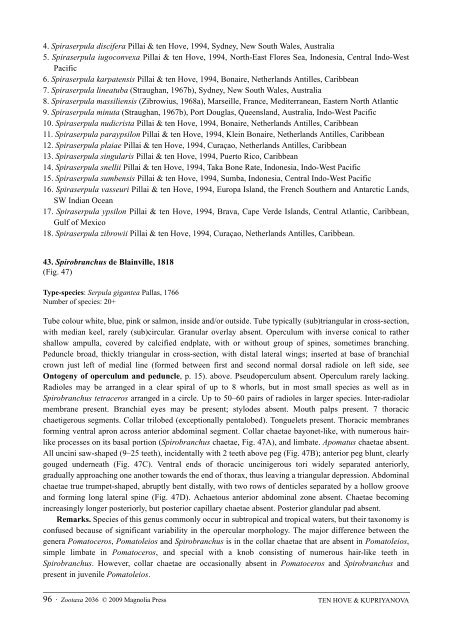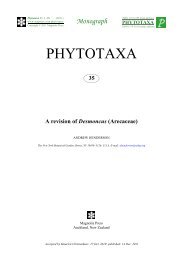Zootaxa, Taxonomy of Serpulidae (Annelida ... - Magnolia Press
Zootaxa, Taxonomy of Serpulidae (Annelida ... - Magnolia Press
Zootaxa, Taxonomy of Serpulidae (Annelida ... - Magnolia Press
Create successful ePaper yourself
Turn your PDF publications into a flip-book with our unique Google optimized e-Paper software.
4. Spiraserpula discifera Pillai & ten Hove, 1994, Sydney, New South Wales, Australia<br />
5. Spiraserpula iugoconvexa Pillai & ten Hove, 1994, North-East Flores Sea, Indonesia, Central Indo-West<br />
Pacific<br />
6. Spiraserpula karpatensis Pillai & ten Hove, 1994, Bonaire, Netherlands Antilles, Caribbean<br />
7. Spiraserpula lineatuba (Straughan, 1967b), Sydney, New South Wales, Australia<br />
8. Spiraserpula massiliensis (Zibrowius, 1968a), Marseille, France, Mediterranean, Eastern North Atlantic<br />
9. Spiraserpula minuta (Straughan, 1967b), Port Douglas, Queensland, Australia, Indo-West Pacific<br />
10. Spiraserpula nudicrista Pillai & ten Hove, 1994, Bonaire, Netherlands Antilles, Caribbean<br />
11. Spiraserpula paraypsilon Pillai & ten Hove, 1994, Klein Bonaire, Netherlands Antilles, Caribbean<br />
12. Spiraserpula plaiae Pillai & ten Hove, 1994, Curaçao, Netherlands Antilles, Caribbean<br />
13. Spiraserpula singularis Pillai & ten Hove, 1994, Puerto Rico, Caribbean<br />
14. Spiraserpula snellii Pillai & ten Hove, 1994, Taka Bone Rate, Indonesia, Indo-West Pacific<br />
15. Spiraserpula sumbensis Pillai & ten Hove, 1994, Sumba, Indonesia, Central Indo-West Pacific<br />
16. Spiraserpula vasseuri Pillai & ten Hove, 1994, Europa Island, the French Southern and Antarctic Lands,<br />
SW Indian Ocean<br />
17. Spiraserpula ypsilon Pillai & ten Hove, 1994, Brava, Cape Verde Islands, Central Atlantic, Caribbean,<br />
Gulf <strong>of</strong> Mexico<br />
18. Spiraserpula zibrowii Pillai & ten Hove, 1994, Curaçao, Netherlands Antilles, Caribbean.<br />
43. Spirobranchus de Blainville, 1818<br />
(Fig. 47)<br />
Type-species: Serpula gigantea Pallas, 1766<br />
Number <strong>of</strong> species: 20+<br />
Tube colour white, blue, pink or salmon, inside and/or outside. Tube typically (sub)triangular in cross-section,<br />
with median keel, rarely (sub)circular. Granular overlay absent. Operculum with inverse conical to rather<br />
shallow ampulla, covered by calcified endplate, with or without group <strong>of</strong> spines, sometimes branching.<br />
Peduncle broad, thickly triangular in cross-section, with distal lateral wings; inserted at base <strong>of</strong> branchial<br />
crown just left <strong>of</strong> medial line (formed between first and second normal dorsal radiole on left side, see<br />
Ontogeny <strong>of</strong> operculum and peduncle, p. 15). above. Pseudoperculum absent. Operculum rarely lacking.<br />
Radioles may be arranged in a clear spiral <strong>of</strong> up to 8 whorls, but in most small species as well as in<br />
Spirobranchus tetraceros arranged in a circle. Up to 50–60 pairs <strong>of</strong> radioles in larger species. Inter-radiolar<br />
membrane present. Branchial eyes may be present; stylodes absent. Mouth palps present. 7 thoracic<br />
chaetigerous segments. Collar trilobed (exceptionally pentalobed). Tonguelets present. Thoracic membranes<br />
forming ventral apron across anterior abdominal segment. Collar chaetae bayonet-like, with numerous hairlike<br />
processes on its basal portion (Spirobranchus chaetae, Fig. 47A), and limbate. Apomatus chaetae absent.<br />
All uncini saw-shaped (9–25 teeth), incidentally with 2 teeth above peg (Fig. 47B); anterior peg blunt, clearly<br />
gouged underneath (Fig. 47C). Ventral ends <strong>of</strong> thoracic uncinigerous tori widely separated anteriorly,<br />
gradually approaching one another towards the end <strong>of</strong> thorax, thus leaving a triangular depression. Abdominal<br />
chaetae true trumpet-shaped, abruptly bent distally, with two rows <strong>of</strong> denticles separated by a hollow groove<br />
and forming long lateral spine (Fig. 47D). Achaetous anterior abdominal zone absent. Chaetae becoming<br />
increasingly longer posteriorly, but posterior capillary chaetae absent. Posterior glandular pad absent.<br />
Remarks. Species <strong>of</strong> this genus commonly occur in subtropical and tropical waters, but their taxonomy is<br />
confused because <strong>of</strong> significant variability in the opercular morphology. The major difference between the<br />
genera Pomatoceros, Pomatoleios and Spirobranchus is in the collar chaetae that are absent in Pomatoleios,<br />
simple limbate in Pomatoceros, and special with a knob consisting <strong>of</strong> numerous hair-like teeth in<br />
Spirobranchus. However, collar chaetae are occasionally absent in Pomatoceros and Spirobranchus and<br />
present in juvenile Pomatoleios.<br />
96 · <strong>Zootaxa</strong> 2036 © 2009 <strong>Magnolia</strong> <strong>Press</strong><br />
TEN HOVE & KUPRIYANOVA
















